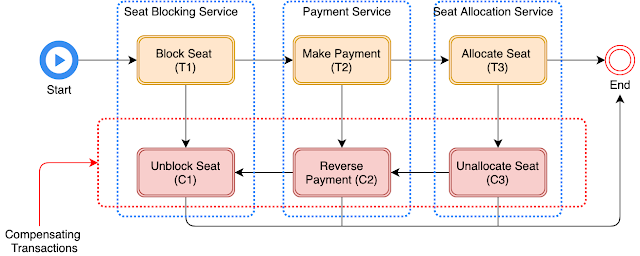Açıklaması şöyle.
In this approach, there is no central orchestrator. Each service participating in the Saga performs their transaction and publish events. The other services act upon those events and perform their transactions. Also, they may or not publish other events based on the situation.
Yani her servis akıştan haberdar. Açıklaması şöyle. Choreography-Based Saga Örüntüsü basit işler için kullanılabilir ve karmaşık transaction'larda pek iyi sonuç vermiyor.
In this approach, the services themselves are aware of the flow of the operations. After an initial message is sent to a service operation, it generates the next message to be sent to the following service operation. The service needs to have explicit knowledge of the flow of the transaction leading to more coupling between services.
Choreography-Based Saga Bağlamında Event Driven Architecture (EDA)
Şeklen şöyle
Compensation OperationsAçıklaması şöyle
Here, we can see that the flow starts from the client that sends the initial message to the first service through its input message queue. In its business logic, it can carry out its data-related operations in a local transaction defined within the service. After the operations are done, the overall workflow adds a message to the request queue of the next service in the choreography. In this manner, the overall transaction context will be propagated through these messages to each of the services until completion.In the case of failure in a service in the workflow, we need to rollback the overall transaction. For this, starting from the service which incurred the failure, it will clean up its resources, and send a message through a compensation queue to the service that was executed right before. This moves the execution of the previous step, does any compensation actions to rollback the changes done by its local transaction, and repeats the operation of contacting its previous service for compensation operations. In this, the error handling chain will reach the first service that will then ultimately send a message to the response queue. This is connected to the client to notify that an error has occurred and the total transaction has been rolled back successfully using compensation actions.As seen in the synchronous service invocation approach, when executing the local transactions in their respective services, we should maintain a transaction history table to ensure we don’t repeat the local operations in case the service receives duplicate messages. Also, in order to not lose the continuity of the workflow, a service should acknowledge the message from its request queue only after the database transaction is done and the next message is added to the request queue of the following service. This flow makes sure we don’t lose any messages and the overall transaction will finish executing either by succeeding or rolling back all the operations.
Compensating Action'ları çalıştırmak gerekir. Şeklen öyle


Hiç yorum yok:
Yorum Gönder